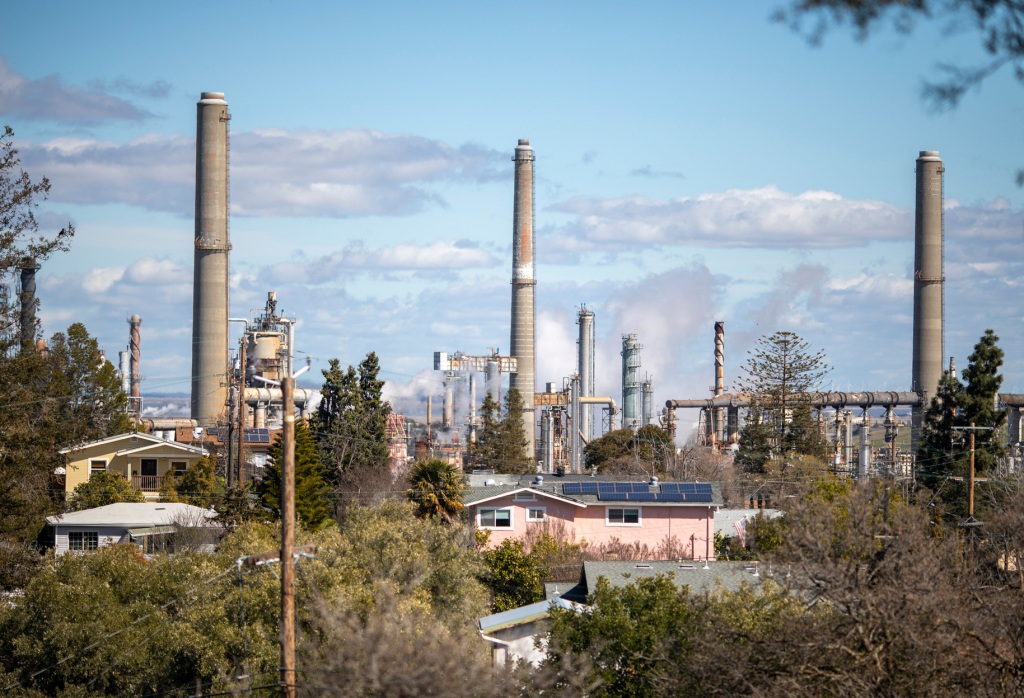Tens of thousands of people living near the Martinez Refinery Company still don’t know for certain if—or to what extent—they were poisoned last November.
But five months after 24 tons of toxic, dusty residue from gasoline, diesel and jet fuel flowing through the refinery first showered down on its next-door neighbors, new soil samples collected this week may finally confirm what dangers still linger there by late May or early June, county health officials announced Thursday.
Last Thanksgiving, the company posted on Facebook that the fine white substance that blanketed cars, porches and plants over the holiday was from a “non-toxic”, “non-hazardous” and “naturally occurring” catalyst dust expelled from its facility on the edge of town.
But within a few days, the Contra Costa County Health Department alerted residents that the ashy grit actually contained aluminum, barium, chromium and other hazardous metals — chemicals that are linked to nausea, vomiting, respiratory issues, immune system dysfunction, cancer and even death.
People living nearby were told in March to discard any food grown in gardens and fruit trees, just to be safe.
On Thursday, TRC, a Concord-based environmental consulting firm, started collecting soil samples from 14 different sites neighboring the refinery, which is located at 3485 Pacheco Blvd. Toxicologists will now evaluate the extent of contamination that residents were exposed to through skin contact, inhalation or consumption of food grown in the ground, according to Laura Trozzolo, a senior human health risk assessor with TRC.

She said the soil sample locations were chosen based on a map of where the plume of particles likely landed, using models from the Bay Area Air Quality Management District created using residents’ observations and wind simulations.
Trozzolo said that neither the five-month delay in data collection — due to the county’s lengthy contracting procedures — nor the recent historic storms that drenched the area should negatively impact lab findings.
“If we’ve had any deposition that might have landed on the surface over time, we’re still going to be capturing that within that top six-inch soil layer,” Trozzolo said during a press conference Thursday afternoon. “We do believe that we’re still characterizing and capturing conditions that occurred during that November event.”
Nicole Heath, director of the county’s hazardous materials program, said a 1990s-era industrial safety ordinance allows them to initiate an independent investigation and community risk assessment any time there’s a “major chemical accident or release,” such as the Martinez Refinery Co. event.
She said that ordinance allows the county to form an oversight committee, which brings together elected officials, county staff and community members with representatives from the refinery and its labor force.
“An independent incident investigation will look at root cause analyses, which would then determine exactly what happened, why it happened and what can we do to prevent things like this from happening again,” Heath said, later adding that similar chemical releases happened twice before at the refinery in the early 2000s, which was owned by Shell at the time. “We’re responsible, as the oversight committee, for holding the facility accountable.”
Meanwhile, the Contra Costa District Attorney’s office opened up a case in January on the refinery’s failure to notify hazmat officials about the hazardous release, according to Matthew Kaufmann, the county’s deputy health director.
Kaufmann said that while the health department can invoice the refinery to reimburse expenses during their investigation, the DA will be in charge of deciding whether or not the Martinez Refining Company should be responsible for financially compensating residents who lost food and soil.
Physical remediation efforts are also stalled until the upcoming lab results are complete, Heath said.
In the meantime, the county is still recommending that residents impacted by the toxic dust avoid eating any produce planted in the soil. However, gardeners are also encouraged to plant new seeds, in the event that soil samples don’t uncover any hazards.
“We are waiting to have the information from the soil sampling and risk assessment from TRC so that we can provide the answers that we know the community is so desperately, desperately seeking,” Heath said. “These corrective actions are in such a nature that they are intended to prevent something similar from happening again.”

𝗖𝗿𝗲𝗱𝗶𝘁𝘀, 𝗖𝗼𝗽𝘆𝗿𝗶𝗴𝗵𝘁 & 𝗖𝗼𝘂𝗿𝘁𝗲𝘀𝘆: www.mercurynews.com
𝗙𝗼𝗿 𝗮𝗻𝘆 𝗰𝗼𝗺𝗽𝗹𝗮𝗶𝗻𝘁𝘀 𝗿𝗲𝗴𝗮𝗿𝗱𝗶𝗻𝗴 𝗗𝗠𝗖𝗔,
𝗣𝗹𝗲𝗮𝘀𝗲 𝘀𝗲𝗻𝗱 𝘂𝘀 𝗮𝗻 𝗲𝗺𝗮𝗶𝗹 𝗮𝘁 dmca@enspirers.com


